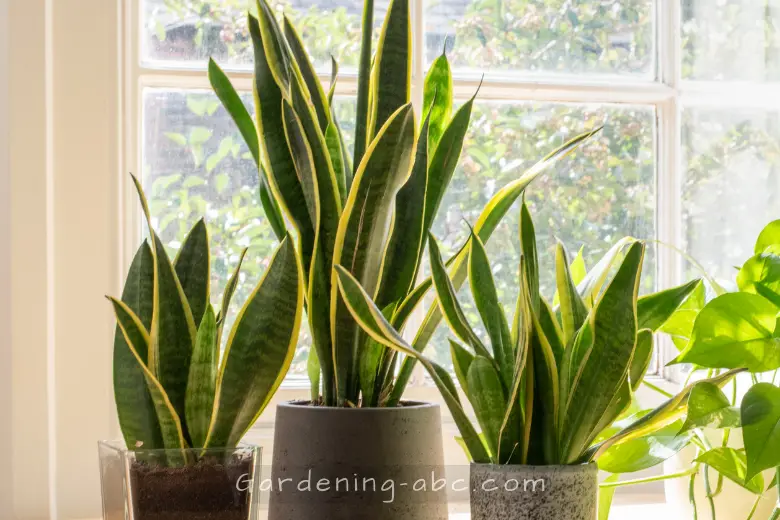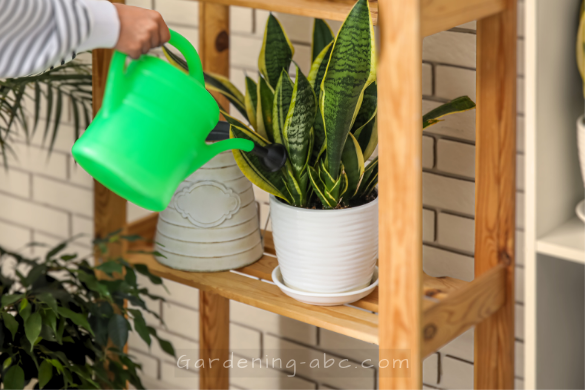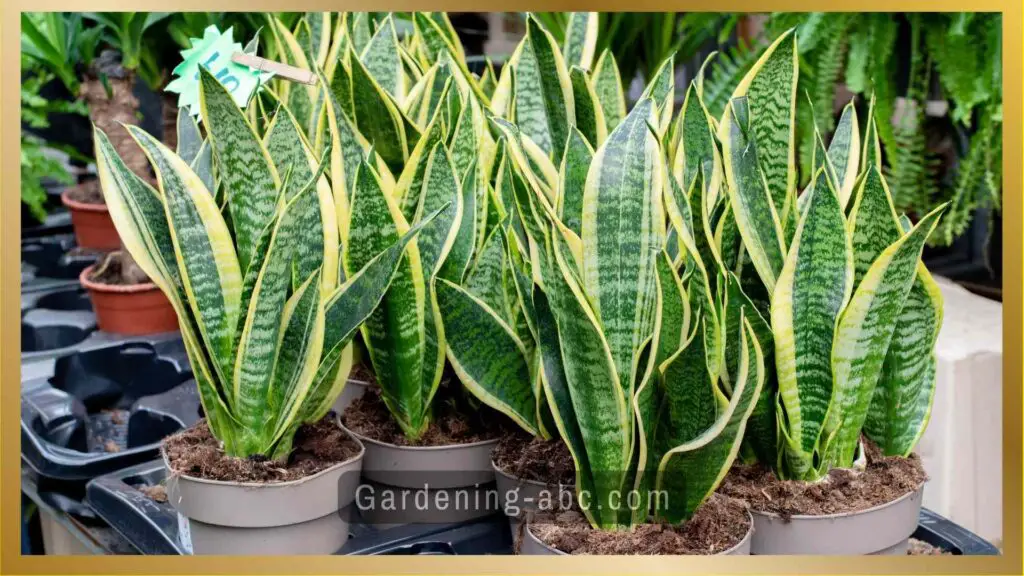We use affiliate links to run our site. When you buy through links on our site, we may earn an affiliate commission, without any added cost to you. Learn more
If you’re a proud owner of a snake plant, you may be wondering about the optimal watering frequency. Snake plants are known for their resilience and air-purifying qualities, but watering them correctly is crucial for their health and growth.
In this comprehensive guide, we will delve into the factors that influence watering, provide practical tips, and outline the optimal watering frequency to ensure your snake plant thrives.
Why Watering Your Snake Plant is so crucial
Watering is a vital aspect of any plant care, and snake plants are no exception. Finding the right balance between overwatering and underwatering is essential for the overall well-being of your plant. Too much water can lead to root rot, while too little can cause dehydration.
How Often to Water a Snake Plant to Keep It Healthy?
To properly water a Snake plant, it’s recommended to wait until the soil is completely dry before watering again. In the warmer seasons, this is typically around once a week, while in the cooler months, it may extend to every 14-21 days.
So to be absolutely sure about when to water your snake plants you need to consider other factors.
The Rare and Fascinating World of Snake Plant Flowers
Factors Influencing Watering Frequency
To determine how often you should water your snake plant, it’s crucial to consider the following factors
1. Environmental Conditions
The environment in which your snake plant resides plays a significant role in its watering needs. Factors such as temperature, humidity, and air circulation affect how quickly the soil dries out.
For instance, snake plants in warmer and drier conditions may require more frequent watering compared to those in cooler and more humid environments.
2. Potting Mix and Drainage
The type of potting mix and the container’s drainage capabilities directly impact how water is retained or drained from the soil. Snake plants thrive in well-draining soil that allows excess water to escape easily.
If your potting mix retains water for prolonged periods, it’s essential to adjust your watering frequency accordingly.
3. Plant Size and Growth Stage
The size and growth stage of your snake plant also influences its water requirements. Established plants with larger root systems generally need more water compared to smaller, newly potted ones.
Additionally, actively growing snake plants may require more frequent watering to support their development.
4. Seasonal Variations
Seasonal changes affect both indoor and outdoor plants, including snake plants. During warmer months or active growth periods, snake plants may require more frequent watering due to increased evaporation rates.
Conversely, in colder months or dormancy periods, the watering frequency may decrease.
Snake Plants Can Hold onto the water for a longer period of time:
Snake plants, store water in their thick leaves and utilize a unique photosynthesis process called CAM(only open their stomata at night to prevent transpiration) to minimize water loss.
This adaptation allows them to withstand intense weather conditions. Their water-holding capacity enables them to endure drought periods, although overwatering can lead to root rot.
Optimal Watering Frequency
Now that we’ve explored the factors that affect watering, let’s delve into the optimal watering frequency for snake plants. Remember, these are general guidelines, and you should always assess your specific plant’s needs.
1. Check Soil Moisture
The most reliable way to determine if your snake plant needs watering is by checking the moisture level of the soil. Insert your finger or a moisture meter about an inch into the soil to assess its dryness. If the soil feels dry, it’s time to water your plant.
2. Avoid Overwatering
Overwatering is a common mistake that can harm snake plants. It’s essential to ensure the soil is dry before watering again. Excessive moisture can lead to root rot, which is challenging to reverse. Remember, it’s better to be underwater than overwater your snake plant.
3. Watering Frequency
On average, snake plants require watering every 2-4 weeks. However, this can vary based on the factors discussed earlier. During the active growing season or in warmer and drier environments, you may need to water more frequently. In contrast, during dormancy or in cooler and more humid conditions, watering less often is suitable.
4. Observe and Adjust
Observe your snake plant closely after watering. If the leaves appear wilted or droopy, it may be a sign of underwatering. Conversely, if the leaves start turning yellow or feel mushy, it could indicate overwatering. By closely monitoring your plant’s response, you can fine-tune the watering frequency to meet its specific needs.
Signs of Overwatering or Underwatering Your Snake Plant
Watering your snake plant appropriately is essential for its well-being. However, it’s crucial to strike the right balance to avoid overwatering or underwatering, both of which can harm your plant. Here are the signs to watch out for:
Overwatering:
- Yellowing leaves: If the leaves of your snake plant turn yellow, mushy, or show signs of rot, it’s likely due to overwatering. Excessive moisture can lead to root rot, causing the leaves to deteriorate.
- Wilting or drooping: Overwatered snake plants may exhibit wilting or drooping leaves, even when the soil feels moist. This is a sign that the roots are suffocating and unable to absorb oxygen properly.
- Foul odor: If you notice a foul smell emanating from the soil or the plant itself, it could indicate overwatering. The excess moisture creates an ideal environment for fungal and bacterial growth.
Underwatering:
- Dry, crispy leaves: When your snake plant is underwatered, the leaves may become dry, brittle, or develop crispy edges. Lack of water deprives the plant of hydration, causing the leaves to wither.
- Leaf curling: Underwatered snake plants may exhibit curling leaves as a response to conserve moisture. The leaves curl inwards to minimize surface area, reducing water loss through evaporation.
- Slow growth or stunted size: Insufficient water supply can hinder the growth of your snake plant. If you notice slower growth or smaller leaves than usual, it may be a sign of underwatering.
Tips for Successful Watering

To ensure your snake plant thrives and flourishes, consider the following tips:
- Select a Well-Draining Potting Mix: Opt for a soil mix specially formulated for succulent or cacti plants. This facilitates effective drainage and fosters robust root growth.
- Choose an Appropriate Container: When selecting a container for your snake plant, opt for one equipped with drainage holes. This facilitates the escape of excess water, preventing it from pooling at the bottom and potentially inducing root rot.
- Water Thoroughly: When it comes to watering your snake plant, ensure the soil is thoroughly saturated until water trickles out through the drainage holes. This practice aids in eliminating salt buildup and guarantees that the entire root system receives ample moisture.
- Steer Clear of Stagnant Water: Discard any stagnant water that accumulates in the saucer or cache pot post-watering. Allowing your snake plant to linger in standing water can precipitate root rot and a myriad of other issues.
- Consider Seasonal and Environmental Factors: Adapt your watering frequency in accordance with seasonal changes and the specific environmental conditions your snake plant is exposed to.
By adhering to these guidelines and making the necessary adjustments to your watering routine, you can create an environment that fosters the optimal growth and well-being of your snake plant.
Can I use tap water for watering my snake plant, or should I opt for other water sources?
Tap water is generally suitable for snake plants. However, if your tap water is heavily chlorinated or has a high mineral content, it’s advisable to use filtered or distilled water to prevent any potential damage to the plant.
What are the best watering techniques or methods for snake plants?
The best watering technique for snake plants is to thoroughly saturate the soil during each watering session and allow excess water to drain away. Avoid leaving the plant in standing water, as it can lead to root rot.
Is it better to water snake plants from the top or bottom?
It’s recommended to water snake plants from the top, directly onto the soil. This allows the water to reach the roots effectively. However, bottom watering can also be done by placing the pot in a saucer filled with water and allowing the plant to absorb moisture through the drainage holes.
Are there any specific watering tips for snake plants during different seasons?
During the active growing season, which is typically spring and summer, snake plants may require more frequent watering. In contrast, during the dormant period in fall and winter, watering should be reduced to accommodate the plant’s slower growth.
How can I prevent root rot in snake plants caused by excessive watering?
To prevent root rot, it’s crucial to ensure proper drainage by using a well-draining potting mix and a container with drainage holes. Additionally, avoid overwatering and allow the soil to dry out between waterings.
What should I do if I accidentally overwater my snake plant?
If you accidentally overwater your snake plant, remove it from the excess water and let the soil dry out. Avoid watering until the soil has completely dried to prevent further damage. If necessary, repot the plant in fresh, well-draining soil.
Can I use self-watering systems or watering globes for my snake plant?
While snake plants are relatively resilient, it’s generally recommended to avoid using self-watering systems or watering globes. These can lead to overwatering, which can be detrimental to the plant’s health.
Are there any alternative methods of watering snake plants, such as using a humidifier?
Snake plants do not require high humidity levels, so using a humidifier solely for watering purposes is not necessary. However, maintaining moderate indoor humidity levels can benefit the overall health of the plant.
Conclusion
Proper watering is essential for maintaining a healthy snake plant. By understanding the factors that influence watering frequency and following the recommended guidelines, you can ensure your snake plant thrives and remains a beautiful addition to your indoor space.
Remember, each snake plant is unique, so pay attention to its individual needs and adjust your watering routine accordingly. With care and attention, your snake plant will continue to flourish and bring joy to your home or office for years to come.
If you found this post helpful, please share it with your friends and family who might also want to grow snake plants. You can also explore more articles on our site about Snake Plants and other houseplants
Amazon and the Amazon logo are trademarks of Amazon.com, Inc, or its affiliates.

Hi there! My name is Prasenjit and I’m an avid gardener and someone who has grown a passion for growing plants. From my hands-on experience, I have learned what works and what doesn’t. Here I share everything I have learned.

